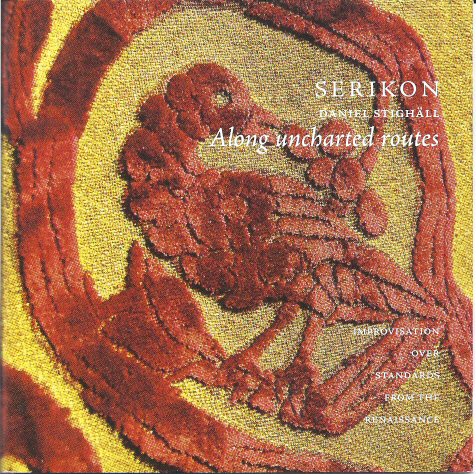
Serikon, dir. Daniel Stighäll, Along Uncharted Routes: Improvisation over Standards from the Renaissance, (Footprint Records, FRCD 056), Recorded 15-16 May 2009 and 26-26 November 2010.
It is ironic that the modern impression of sixteenth-century diminution practice has been so formed by a number of pieces given as examples in didactic treatises by figures such as Diego Ortiz, Girolamo dalla Casa, and Francesco Rognoni, among others. While these works do indeed give a compelling sense of the vocabulary of florid ornamentation so characteristic of late sixteenth-century Italian music, as fully notated works they come freighted with a degree of fixity that veils what is arguably the essence of the practice: improvisation. In the veiling we often seem to lose sight of the dynamic of spontaneity, as the “division piece” becomes a florid, fixed composition to be negotiated by the player or singer, rather than a dynamic process through which compositions are enlivened and graced. As the title implies, in Along Uncharted Routes, the superb Swedish ensemble Serikon takes a different path, offering performances of the same sort of pieces that Ortiz, dalla Casa, and Rognoni enshrined as examples—“Susane un jour,” “Anchor che col partire,” etc.—but with improvised diminutions. Of course, the recording medium itself introduces an unavoidable degree of irony, for with repeated hearings the renditions take on a certain fixity, as with written examples, but significantly, the improvisational element is easily discerned nonetheless, and is very gratifying. This seems especially evident in the wonderful version of “Susane un jour,” where the embellishment from within the ensemble by mute cornett and trombone had the effect of creating an easy fluidity and flavorful seasoning rather than attempting to steal the show with long-rehearsed, musical pyrotechnics.
Additionally, Along Uncharted Routes shows a wide range of approaches that an ensemble can take in rendering diminution pieces. Here there are examples of a sung melody with polyphonic voices played and embellished, an ornamented upper voice played to the accompaniment of lower instrumental parts, and keyboard and plucked string reductions of the polyphony with the upper voice ornamented. The more successful route seems to be where individual polyphonic lines are preserved, rather than reduced on a non-sustaining instrument. The preservation of the inner lines seems not only to offer a functional counterweight to the floridity of the ornamental line, but also keeps the harmonies clear, as the theorist Vicentino reminds: “To avoid losing harmony in composition while singers display a refined talent for diminuition, it is a good idea to have such diminution accompanied by instruments that play the composition accurately, without diminution. For harmony cannot be lost through diminution if the instrument holds the consonances for their full value” (trans. Anne Smith).
The ensemble is an engaging one that understands the synergy of collaboration. Yet individually there is also much to savor. The beautiful cornett playing by William Dongois is wonderfully vowel-rich, with gracefully contoured phrasing and an exceedingly gratifying low register. Daniel Stighäll’s trombone playing is both as sensitive as it is agile. The main focus of the recording is the improvisational rendition of standard works. But for good measure, the ensemble has also included a few composed division pieces—Notari’s “Ben qui si mostra” (Cipriano da Rore) and Francesco Rognoni’s “Pulchra es” (Palestrina)—as well as a modern work for tenor sackbut by Aron Hidman.
If Serikon’s musical routes are “uncharted,” we might in the future all hope they become more frequently traveled paths, and for that particular journey the members of Serikon will continue to prove wonderfully congenial traveling companions. Buon viaggio!
-- Steven Plank



